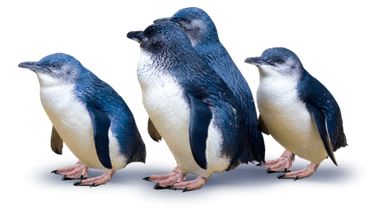 Last Monday night, 37 Rotarians, with family and friends, accompanied by 12 tourists, paid a visit to see rafts (yes, that’s the collective noun) of Little Blue Penguins (or Korora) come ashore at Takiharuru/Pilots Beach by Pukekura/Taiaroa Head.
Last Monday night, 37 Rotarians, with family and friends, accompanied by 12 tourists, paid a visit to see rafts (yes, that’s the collective noun) of Little Blue Penguins (or Korora) come ashore at Takiharuru/Pilots Beach by Pukekura/Taiaroa Head.Before we went outside, we learned of the history of the area, as well as the nature of these little creatures, being the smallest penguin species on earth.
Walking down through the reserve we saw evidence of a lot of planting and other work to create a suitable and safe environment for these birds. Even though it was barely dusk we were privileged to see them come ashore after they had spent all day in the water, venturing 10 kilometres out to sea.
Normally they come in after dark, as the later ones did. The tiered platform area allows for excellent viewing of the penguins scurrying across the beach to the safety of the reserve and their nests. It also allows for spectator movement and leaning over the rails to obtain a very close-up view of these cute beings as they pass by.
The guides were both knowledgeable and approachable. They are clearly committed to the maintenance and further development of the area. The numbers in the colony have increased quite significantly because of the conservation work undertaken and now number about 250 pairs, of which we saw most waddle (the collective noun for a group of penguins on land) to their nests.
Walking down through the reserve we saw evidence of a lot of planting and other work to create a suitable and safe environment for these birds. Even though it was barely dusk we were privileged to see them come ashore after they had spent all day in the water, venturing 10 kilometres out to sea.
Normally they come in after dark, as the later ones did. The tiered platform area allows for excellent viewing of the penguins scurrying across the beach to the safety of the reserve and their nests. It also allows for spectator movement and leaning over the rails to obtain a very close-up view of these cute beings as they pass by.
The guides were both knowledgeable and approachable. They are clearly committed to the maintenance and further development of the area. The numbers in the colony have increased quite significantly because of the conservation work undertaken and now number about 250 pairs, of which we saw most waddle (the collective noun for a group of penguins on land) to their nests.
This attraction is a hidden treasure, about which I knew very little prior to the visit, and it is a real jewel in Dunedin’s eco-tourism crown. TripAdvisor rates it in the top 10 best experiences in New Zealand. You must go, if you haven’t already, and take your visitors too.
The visit was another Community Projects Team undertaking, led by Brian Daniels and Bruce Collier. As well as being a wonderful fellowship event, it raised in excess of $600 towards our club’s centennial
projects, thanks to Blue Penguins Pukekura.
The visit was another Community Projects Team undertaking, led by Brian Daniels and Bruce Collier. As well as being a wonderful fellowship event, it raised in excess of $600 towards our club’s centennial
projects, thanks to Blue Penguins Pukekura.

